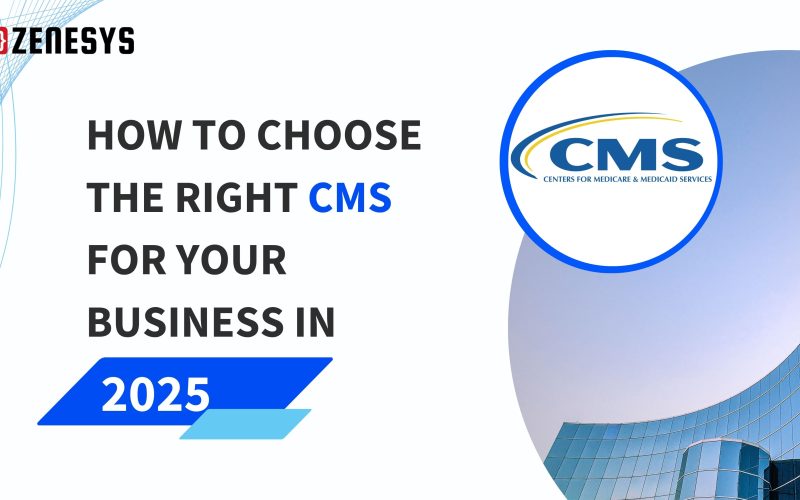If you’re reading this, you probably know how much the web has changed in the last few years. In 2025, businesses are expected to spend over $20 billion globally on content management software, according to Statista.
That’s a big jump from just a few years ago, showing how important digital content has become for companies of all sizes. In fact, a recent Statista report found that over 77% of businesses consider their CMS a “critical” part of their digital strategy.
Let’s face it: customers expect more. They want websites that load quickly, work on any device, and feel personal. As digital expert Jane Doe puts it, “A CMS isn’t just a backend tool anymore—it’s the engine that drives your entire digital experience.” If your CMS can’t keep up, you risk losing visitors, sales, and even your brand’s reputation.
So, how do you pick the right CMS for your business in 2025? It’s not about chasing the latest buzzwords or picking what everyone else uses. It’s about understanding your needs, your team’s skills, and where you want your business to go.
What Is a CMS? (And Why Should You Care?)
Before we go further, let’s clear up what a CMS actually is. A CMS is software that lets you create, manage, and update digital content—usually for a website—without needing to write code every time.
A CMS is like the main hub for managing what you do online. You may have heard of well-known CMS options such as WordPress, Shopify, Wix, and Drupal. There are many more choices available, especially now with newer kinds like headless CMS and platforms that use artificial intelligence.
Why does this matter? Because the right CMS can:
- Save you time and money on website updates
- Enable better teamwork, even among those unfamiliar with technology.
- Improve your website’s speed, security, and user-friendliness.
- Assist in achieving your marketing, sales, and customer support objectives.
But the wrong CMS? It can slow you down, frustrate your team, and make your business look outdated.
Step 1: Start with Your Business Needs
Here’s the truth: there’s no “best” CMS for everyone. The top CMS is the one that suits your company perfectly.
Questions to Ask Yourself
- What’s the main goal of your website? (Selling products? Sharing news? Generating leads?)
- Who will be updating the site? (Developers, marketers, customer service?)
- Do you need special features? (E-commerce, multilingual support, memberships?)
- What are your current and future spending limits?
- Will your website need to grow or change soon?
In my experience, businesses that skip this step often end up switching CMS platforms later—a costly and stressful process.
Step 2: Get the Idea of the Types of CMS
The CMS world isn’t just about WordPress anymore. Here’s a quick rundown of the main types you’ll see in 2025:
| CMS Type | Best For | Pros | Cons |
| Traditional CMS | Blogs, small business sites | Easy to use, lots of plugins/themes | Can be less flexible for custom needs |
| Headless CMS | Apps, complex sites, omnichannel | Flexible, great for mobile/apps, future-proof | Requires more technical skill |
| Hybrid CMS | Growing businesses, agencies | Mix of traditional and headless, scalable | Can be complex to set up |
| No-code/Low-code | Non-technical teams, quick sites | Fast setup, user-friendly, drag-and-drop | Limited customization |
| Enterprise CMS | Large organizations | Advanced features, security, integrations | Expensive, steep learning curve |
Step 3: Match the CMS to Your Team’s Skills
Not every business has a team of web developers on standby. That’s totally fine. But your CMS should match what your team can handle.
- No tech team? Look for no-code or low-code CMS options. These are designed to be simple, with drag-and-drop editors and built-in help.
- Some tech skills? You can consider platforms that offer more customization, like Kentico, Sitecore, WordPress or Drupal.
- Full development team? You might want a headless CMS or something more flexible, especially if you’re building custom apps or need advanced integrations.
Step 4: Think About Growth and Scalability
Your company may be small today, but what will it be like in the future? You need a CMS that can handle your growth.
- Can the CMS handle more traffic and content as you grow?
- Does it offer features for multiple languages, locations, or brands?
- Is it easy to add new users, roles, or permissions?
A scalable CMS means you won’t have to start over when your business takes off.
Step 5: Don’t Ignore Security and Compliance
Websites get hacked. Data leaks happen. In 2025, customers expect their information to be safe, and governments are setting stricter rules (like GDPR and CCPA).
Ask these questions:
- How does the CMS handle security updates and patches?
- Does it offer built-in tools for privacy and compliance?
- Can you control who has access to different parts of your site?
If your business handles sensitive data, this step is non-negotiable.
Step 6: Integration with Other Tools
Most businesses use more than just a website. You probably have email marketing, customer relationship management (CRM), analytics, and more.
- Does the CMS connect easily with your other tools?
- Are there plugins or APIs for what you need?
- Is it easy to automate tasks, like sending leads to your sales team?
A CMS that plays well with others will save you time and headaches down the road.
Step 7: Check Support and Community
Even the best CMS can run into issues. When that happens, you want help—fast.
- Is there a strong support team or community?
- Are there tutorials, forums, or documentation?
- Can you find developers or agencies who know the platform?
A big, active community means you’re less likely to get stuck.
Step 8: Look at Total Cost of Ownership
It’s tempting to just look at the sticker price, but the real cost of a CMS includes:
- Licensing or subscription fees
- Hosting costs (if self-hosted)
- Costs for plugins, themes, or add-ons
- Development or customization costs
- Ongoing maintenance and updates
Sometimes a “free” CMS ends up costing more because of hidden fees or extra work.
Step 9: Try Before You Buy
Most CMS platforms offer free trials or demo versions. Take advantage of these!
- Set up a test site
- Try adding and editing content
- Check how easy it is to use
- Test integrations with your other tools
If something feels clunky or confusing now, it’ll only get worse later.
Step 10: Get Input from Your Team
Your website isn’t just for IT—it’s for marketing, sales, customer service, and more. Ask for feedback from everyone who’ll use the CMS.
- What features do they need?
- What do they find confusing?
- What would make their jobs easier?
The best CMS is one your whole team can use confidently.
Popular CMS Platforms in 2025 (with Pros and Cons)
Here’s a quick look at some of the top CMS platforms this year:
| CMS | Ideal For | Pros | Cons |
| WordPress | Blogs, small biz | Huge community, flexible | Needs regular updates |
| Shopify | E-commerce | Easy store setup, secure | Monthly fees, less flexible |
| Wix | Small sites | Drag-and-drop, fast setup | Limited for complex needs |
| Webflow | Designers/agencies | Visual design, no code | Learning curve |
| Drupal | Large/complex sites | Customizable, secure | Needs tech skills |
| Contentful | Headless, apps | API-first, scalable | More technical setup |
| Sitecore | Enterprise | Advanced features | Expensive, complex |
How to Work with a CMS Development Company
If you don’t have the skills in-house, it might make sense to hire a CMS Development Company. They can help you:
- Define your requirements
- Customize your CMS
- Integrate with your other tools
- Train your team
Just be sure to choose a company with experience in your chosen CMS and a track record of successful projects.
Final Thoughts
Choosing a CMS isn’t just a technical decision—it’s a business one. Take your time, involve your team, and focus on what you really need. The right CMS will help your business grow, adapt, and connect with your customers—today and in the future.
If you have any questions or want to share your own experience, drop a comment below. I’ve seen firsthand how the right CMS can make all the difference, and I’m happy to help you figure out what works best for you.












